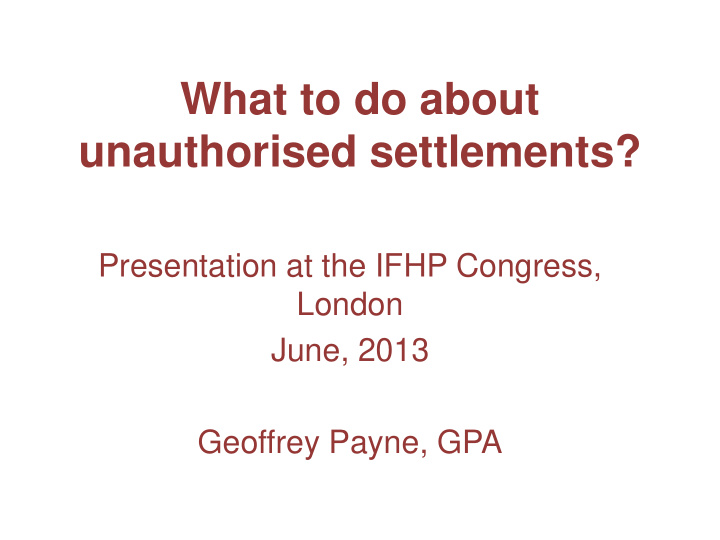



What to do about unauthorised settlements? Presentation at the IFHP Congress, London June, 2013 Geoffrey Payne, GPA
Scale of the challenge • Millions of people in developing countries live without adequate security of tenure or property rights, often in unauthorised settlements. • The UN expects this number to increase by nearly 37 million a year to reach 1.5 billion by 2020 and possibly 2 billion by 2050. • The extent of unauthorised settlements is a reflection on the legal and political system in which they exist. • Forced evictions and market driven displacements are increasing in many countries.
Living on $1 a day in cities requires ingenuity, such as occupying land nobody else wants……
Nature of the challenge • Land and housing embody powerful cultural, historical and political forces which cause many wars, plus low level conflicts as well as suffering
Defining land tenure Land tenure can be defined in many ways. I use: • The mode by which land is held or owned, or the set of relationships among people concerning land or it’s product. Land tenure systems vary considerably between different cultural and economic contexts.
Defining property rights • Property rights are similarly defined as a recognised interest in land or property vested in an individual or group and can apply separately to land or development on it . • Rights may cover access, use, development, inheritance, or transfer and, as such, exist in parallel with ownership. • On this basis, it is clear that the ways in which a society allocates title and rights to land is an important indicator of that society, since rights to land can be held to reflect rights in other areas of public life.
Regimes of tenure and rights • Customary • Statutory (including private, public and communal) and • Religious (eg Islamic). • Legal plurality exists in many countries.
The tenure continuum Within each regime, it is common to find a wide range of categories, including: • Pavement or street dweller • Squatter tenant • Squatter ‘owner’ • Tenant in unauthorised subdivision • Owner of unauthorised subdivision • Legal owner, unauthorised construction • Tenant with formal contract • Leaseholder • Freeholder with mortgage • Freeholder without mortgage.
High Security Degree of security Low security Tenure category Homeless Tenant Possessor Lease-holder Free-holder subdivision (Declaration of Legal owner Unauthorised Tenant in unauthorised Owner in unauthorised Lease-holder (CRRU) Lease-holder (CSHU) Tenant with contract Urban legalisation Pavement dweller Squatter ‘owner’ Squatter tenant construction possession) subdivision Free-holder Property rights X Occupy/use/ X * X * X X X X X X * X * X X * Enjoy X * X * X * X * X * X X * Dispose X X Restrict X * X X X X X * X * Buy X * X * X * X X X X Inherit X * X * X X X X X * X * X* X Develop/improve X * X X X Cultivate/produce X X * X X X X X X * X X X * X Sublet X * X * X X X * X Sublet and fix rent X * X * Pecuniary X X * X X X X X X X X X X X To access services X X * X To access formal credit X *
Tenure policy objectives • Encouraging investment in housing • Improving access to formal credit • Improving the property tax base • Increasing public sector influence over land and housing markets • Improving the efficiency of land and housing markets • Increasing the equity of land and housing markets so that they can reduce inequality in the wider economy
The evolution of tenure policy • Claims and assumptions – property as collateral • The evolving debate • Outcomes and implications
Typical distribution of urban tenure categories by legal status NB: For simplicity, this illustration deletes customary and Islamic tenure categories
Likely consequences of providing titles to ‘owners’ of squatter houses NB: For simplicity, this illustration deletes customary and Islamic tenure categories This figure demonstrates that the provision of full, formal tenure status to informal settlements raises their commercial value and can therefore actually reduce tenure security for the most vulnerable social groups, such as squatter tenants. it also creates new, or intensifies existing, land and property market distortions.
Likely consequences of improving tenure rights in unauthorised settlements NB: For simplicity, this illustration deletes customary and Islamic tenure categories The figure suggests that a rights base approach increases tenure security for the most vulnerable social groups. It also increases social equity without distorting land or property markets.
Tenure policy options Short term tenure options: • MORE (Moratorium on Relocations and Evictions) • Temporary Occupation Licenses (TOL) • Certificate of Comfort Medium term tenure options: • Communal Trust/Lease • Individual lease • Private rental • Certificate of Rights Long term tenure options: – Communal ownership/titles/Communal Property Associations – Co-operative ownership – Condominium ownership – Social concession – Public rental, and – Individual ownership or title.
Principles for progress • Tenure systems are extremely complicated • Social legitimacy is vital • Property ownership is not appropriate for all social groups • Ownership is unlikely to increase access to credit if incomes are low and uncertain • Accept the benefits of a pluralistic approach and diversity of tenure and supply options • Accept that change takes time!
Putting it into practice 1. Stop forced evictions and relocations 2. Upgrade and/or provide short term tenure options in settlements not in environmentally or strategically important locations 3. Undertake a regulatory audit to reduce entry costs to legal land and housing options 4. Promote Multi-Stakeholder Partnerships and a wide range of supply options 5. Start with pilot projects at as large a scale as possible
Thank you! Further information on land tenure issues, including several publications, can be downloaded free at: www.gpa.org.uk
Recommend
More recommend